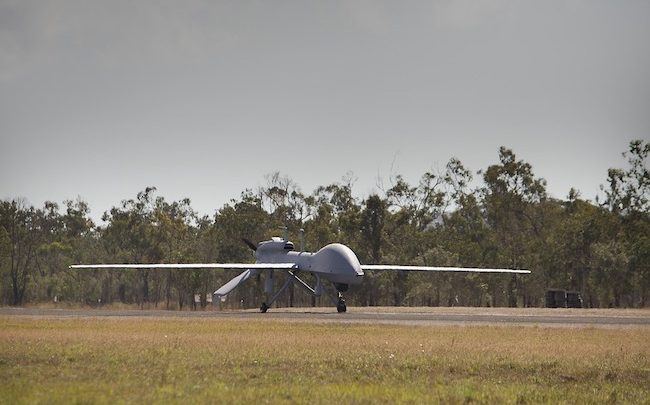
By Syeda Saiqa Bukhari
Advanced military technological innovations have made it possible for forces to inflict fire and fury with bullets and firepower without even being physically involved. Unmanned Aerial Vehicles (UAVs) or drones are one such development that allows nation-states to achieve their strategic goals in such a manner. Within the contemporary world order, war fighting and intelligence gathering techniques have changed considerably. Now, many states are using unmanned aerial vehicles for surveillance, reconnaissance, intelligence, and training of anti-aircraft crews for target acquisition and destruction.
The use of UAV’s emerged in South Asia when they were deployed by the US in its global war against terrorism. India has since also taken the initiative to indigenously develop its own UAV’s, such as the Netra and Rustom I and II drones for surveillance, reconnaissance and for target destruction purposes. More recently India tested its Abhyas drone as a target for its anti-air weapons tests. The Abhyas is a High-speed Expendable Aerial Target (HEAT) which can be used for simulating different types of airplane and missile systems. It can also function as a jammer platform which means that it can confuse the enemy’s integrated air defence systems. These developments are likely to greatly enhance the Indian armed forces’ war fighting capabilities in the years to come.
Attack drones such as the Abhyas are intended to enhance airplane design and to test aircraft performance (maneuverability, cruise and maximum speed) and train its operators by creating realistic threat scenarios. This recent test shows India’s intention to further develop such weapons and to operationalize its aerial defence systems by simulating real war settings. As evident from the Pulwama episode, most of the technologies employed by the Indian Armed Forces were not efficiently used. Learning from these failings, India can thus be seen not only focusing on the development of advanced weapons capabilities but also on their effective usage in war-like situations. For instance, India’s drone capabilities could help facilitate the launch of a limited war under its Cold Start Doctrine, as sufficient Intelligence, reconnaissance and surveillance serves as a vital pre-requisite for its implementation.
Most recently, this kind of unmanned technology was once again in the news in the United States’ ongoing crisis with Iran. Relations between Iran and United State have quickly gone downhill since the US withdrew from JCPOA in May 2018, with last month’s decision by the Trump administration to deploy 1,000 soldiers and extra military resources in Middle East further fueling tensions. In the absence of an official diplomatic channel between the two states, the chances of full-scale conflict are becoming a dangerous possibility.
Under this intensified situation, the US had deployed its ‘Global Hawk’ UAV to scout enemy targets to develop its strategy accordingly. It presented a feasible option for the US to gain information without risking the lives of actual troops as such aerial surveillance drones while being intrusive are unlikely to spark a full-scale war the way an intrusion by a manned fighter aircraft would. In this case too this was not to be as the US refrained from retaliating even when the pilotless drone was shot down by Iran. The situation in contrast would have been quite different if Iran had shot down a fighter aircraft while even possibly killing or even capturing an American pilot instead.
Coming back to the South Asian region, this same aspect when related with India’s recent drone tests would ultimately allow India to undertake similar aerial intrusions against its adversaries without risking actual soldiers’ lives. These include the lives of officers such as Wing Commander Abhinandan who had been recently captured by the Pakistan military in the post Pulwama aerial engagements between both countries. Such developments would thus allow the Indian military to act faster, and conduct more adventurous strikes while reducing the political fallout that may arise from risking the lives of personnel who may otherwise be killed or captured. The unmanned technology also facilitates the Indian temptation to achieve their strategic objectives more efficiently.
In all, such technological advancements have brought about a major shift in warfare considering the increasingly prominent roles being played by such drones. Unmanned technology while currently deployed by a whole host of countries represents perhaps a turning point in the way military operations are conducted, where drones have increasingly come to serve as a best defense alternative for states to achieve their strategic ambitions without risking human lives.
Syeda Saiqa Bukhari is Research Associate at Strategic Vision Institute Islamabad.




